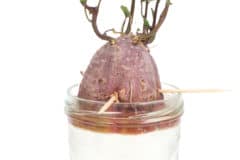Choosing the Potato
Any potato variety can be grown in water. Some of the strongly colored potatoes will have tinted sprouts or leaves, which can be appealing to children. You’ll want a healthy potato that has multiple eyes. Look for one with eyes clustered toward one end or the other, as this makes it easier to get the eyes to sprout. A slightly elongated shape is ideal.
Materials Needed
In addition to the potato, you’ll need the following:
- A cup or glass large enough to contain the potato with some space around the tuber.
- Toothpicks – those with a rounded middle and pointed ends are best.
- Water – any kind. However, if you have hard water, it may leave mineral deposits on a glass container.
Preparing the Potato
Fill the cup about three quarters full with water. Place the potato in the water so the end with the most eyes is submerged at least two inches below the water level. Add or pour out water as necessary. Insert at least four toothpicks about ¼ inch into the potato so the ends balance on top of the container rim. It’s best to space them evenly around the potato.
Growing the Potato
Place the potato in a warm, sunny window. It should have at least six hours of sun to grow well. If it is a south-facing window, you may need some midday shade to protect the potato from too much heat. Check the water level daily and add water as necessary. If the water becomes cloudy or brownish, pour it out and refill with clean water to the same level.
Next Steps
Your potato should develop some roots and begin to sprout within a few weeks. Irish potatoes will grow stems and leaves; they may even reach the stage of flowering. However, the tuber will begin to rot eventually and must be thrown out or planted in the garden or a container with soil. You can grow sweet potatoes in the same manner.












